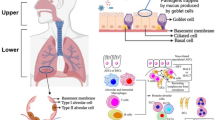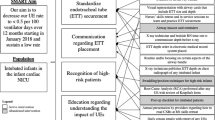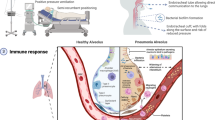Abstract
Objective
We hypothesized that the implementation of evidence-based interventions shaping a bundle approach could significantly reduce the incidence of ventilator-associated pneumonia (VAP) in the neonatal intensive care unit.
Study design
We conducted a prospective observational cohort study including neonates undergoing mechanical ventilation >48 h. VAP rate and endotracheal intubation ratio were compared before (pre-period) and after (post-period) applying VAP prevention bundle strategies.
Result
One hundred seventy-four neonates were included in pre-period (30 months) and 106 in post-period (17 months). Demographic characteristics were comparable and device use ratios were similar. Twenty-eight VAP episodes were diagnosed, 25 in the first period and 3 after the implementation of prevention bundle. This represents a reduction in the incidence rate from 11.79 to 1.93 episodes/1000 ventilator days (p < 0.01).
Conclusion
The implementation of an educational evidence-based program using a bundle approach to prevent VAP has shown a statistically significant reduction in its incidence density.
This is a preview of subscription content, access via your institution
Access options
Subscribe to this journal
Receive 12 print issues and online access
$259.00 per year
only $21.58 per issue
Buy this article
- Purchase on SpringerLink
- Instant access to full article PDF
Prices may be subject to local taxes which are calculated during checkout



Similar content being viewed by others
References
Garland JS. Strategies to prevent ventilator-associated pneumonia in neonates. Clin Perinatol. 2010;37:629–43.
Geslain G, Guellec I, Guedj R, Guilbert J, Jean S, Valentin C, et al. Incidence and risk factors of ventilator-associated pneumonia in neonatal intensive care unit: a first French study. Minerva Anestesiol. 2018;84:829–35.
CDC. Pneumonia (Ventilator-associated [VAP] and non-ventilator-associated Pneumonia [PNEU]) Event. 2021.
Cernada M, Brugada M, Golombek S, Vento M. Ventilator-associated pneumonia in neonatal patients: an update. Neonatology. 2014;105:98–107.
Cernada M, Aguar M, Brugada M, Gutiérrez A, López JL, Castell M, et al. Ventilator-associated pneumonia in newborn infants diagnosed with an invasive bronchoalveolar lavage technique: a prospective observational study. Pediatr Crit Care Med. 2013;14:55–61.
Iosifidis E, Pitsava G, Roilides E. Ventilator-associated pneumonia in neonates and children: a systematic analysis of diagnostic methods and prevention. Future Microbiol. 2018;13:1431–46.
Dell’Orto V, Raschetti R, Centorrino R, Montane A, Tissieres P, Yousef N, et al. Short- and long-term respiratory outcomes in neonates with ventilator-associated pneumonia. Pediatr Pulmonol. 2019;54:1982–8.
Sosa-Hernández O, Matías-Téllez B, Estrada-Hernández A, Cureño-Díaz MA, Bello-López JM. Incidence and costs of ventilator-associated pneumonia in the adult intensive care unit of a tertiary referral hospital in Mexico. Am J Infect Control. 2019;47:e21–5.
Gokce IK, Kutman HGK, Uras N, Canpolat FE, Dursun Y, Oguz SS. Successful implementation of a bundle strategy to prevent ventilator-associated pneumonia in a neonatal intensive care unit. J Tropical Pediatrics. 2018;64:183–8.
Weber CD. Applying adult ventilator-associated pneumonia bundle evidence to the ventilated neonate. Adv Neonatal Care. 2016;16:178–90.
Azab SFA, Sherbiny HS, Saleh SH, Elsaeed WF, Elshafiey MM, Siam AG, et al. Reducing ventilator-associated pneumonia in neonatal intensive care unit using “VAP prevention Bundle”: a cohort study. BMC Infect Dis. 2015;15:4–10.
Chapman AK, Aucott SW, Milstone AM, Esteban E, Ferrer R, Urrea M, et al. Ventilator-associated pneumonia in neonates and children: a systematic analysis of diagnostic methods and prevention. Future Microbiol. 2012;13:1431–46.
World Health Organization. WHO guidelines on hand hygiene in health care first global patient safety challenge clean care is safer care. World Health Organization; Geneva; 2017.
AACN. Ventilator-associated pneumonia precautions for children: what is the evidence? Adv Crit Care. 2019;30:68–71.
VD. R. International Nosocomial Infection Control Consortium report, data summary of 50 countries for 2010-2015: device-associated module. Am J Infect Control. 2016;44:1495–504.
Esteban E, Ferrer R, Urrea M, Suarez D, Rozas L, Balaguer M, et al. The impact of a quality improvement intervention to reduce nosocomial infections in a PICU. Pediatr Crit Care Med. 2013;14:525–32.
Rosenthal VD, Álvarez-Moreno C, Villamil-Gómez W, Singh S, Ramachandran B, Navoa-Ng JA, et al. Effectiveness of a multidimensional approach to reduce ventilator- associated pneumonia in pediatric intensive care units of 5 developing countries: International Nosocomial Infection Control Consortium findings. Am J Infect Control. 2012;40:497–501.
Azab SFA, Sherbiny HS, Saleh SH, Elsaeed WF, Elshafiey MM, Siam AG, et al. Reduction of nosocomial infections and mortality attributable to nosocomial infections in pediatric intensive care units in Lithuania. Medicina. 2015;45:4–10.
Conway Morris A, Kefala K, Simpson AJ, Wilkinson TS, Everingham K, Kerslake D, et al. Evaluation of the effect of diagnostic methodology on the reported incidence of ventilator-associated pneumonia. Thorax. 2009;64:516–22.
Ergenekon E, Çataltepe S. Ventilator-associated pneumonia in the NICU: time to boost diagnostics? Pediatr Res. 2020;87:1143–44.
Parker LA, Weaver M, Murgas Torrazza RJ, Shuster J, Li N, Krueger C, et al. Effect of gastric residual evaluation on enteral intake in extremely preterm infants: a randomized clinical trial. JAMA Pediatr. 2019;173:534–43.
Lin Y, Sun Z, Wang H, Liu M. The effects of gastrointestinal function on the incidence of ventilator-associated pneumonia in critically ill patients. Open Med (Wars). 2018:556–61.
Düzkaya DS, Yildiz S Effect of two different feeding methods on preventing ventilator associated pneumonia in the paediatric intensive care unit (PICU): a randomised controlled study. Aust Crit Care. 2015:1–7.
Manzoni P, de Luca D, Stronati M, Jacqz-Aigrain E, Ruffinazzi G, Luparia M, et al. Prevention of nosocomial infections in neonatal intensive care units. Am J Perinatol. 2013;30:81–8.
Brierley J, Highe L, Hines S, Dixon G. Reducing VAP by instituting a care bundle using improvement methodology in a UK paediatric intensive care unit. Eur J Pediatrics. 2012;171:323–30.
Pepin BJ, Lesslie D, Berg W, Spaulding AB, Pokora T, Harris-Haman PA, et al. ZAP-VAP: a quality improvement initiative to decrease ventilator-associated pneumonia in the neonatal intensive care unit, 2012-2016. Adv Neonatal Care. 2019;19:253–61.
Al-Alaiyan S, Lee PL, Lee W, Chen HL, Garland JS, Conway Morris A, et al. Ventilator associated pneumonia in a neonatal intensive care unit. Thorax. 2017;15:16–21.
Acknowledgements
We would like to thank all the doctors and nurses of the staff for their effort and enthusiasm implementing the bundle in our NICU.
Funding
AP-G and IL-C are both research fellows granted by the Instituto de Investigación Sanitaria La Fe; AP-L acknowledges a Rio Hortega predoctoral grant (CM18/00165) from the Instituto de Salud Carlos III (Ministry of Science and Innovation, Spain); MV and AS-G pertain to the RETICS funded by the PN 2018-2021 (Spain), ISCIII—Sub-Directorate General for Research Assessment and Promotion and the European Regional Development Fund (FEDER), reference RD16/0022.
Author information
Authors and Affiliations
Contributions
AP-G, MC, IL-C, and AP-L designed the data collection instruments, recruited the patients, collected data, and reviewed and revised the manuscript. AP-G, AS-G, and MC carried out the analyses, and reviewed and revised the manuscript. MC, AG, II, and MV conceptualized and designed the study, coordinated and supervised data collection, and critically reviewed the manuscript for important intellectual content. All authors approved the final manuscript as submitted and agree to be accountable for all aspects of the work.
Corresponding authors
Ethics declarations
Conflict of interest
The authors declare no competing interests.
Additional information
Publisher’s note Springer Nature remains neutral with regard to jurisdictional claims in published maps and institutional affiliations.
Rights and permissions
About this article
Cite this article
Pinilla-González, A., Solaz-García, Á., Parra-Llorca, A. et al. Preventive bundle approach decreases the incidence of ventilator-associated pneumonia in newborn infants. J Perinatol 41, 1467–1473 (2021). https://doi.org/10.1038/s41372-021-01086-7
Received:
Revised:
Accepted:
Published:
Issue date:
DOI: https://doi.org/10.1038/s41372-021-01086-7
This article is cited by
-
H-ER-O-S: A Quality Improvement Initiative to Reduce Ventilator-Associated Pneumonia in a Level IIIb Neonatal Intensive Care Unit of a Tertiary Care Public Hospital
Indian Pediatrics (2025)
-
The spectrum of pneumonia among intubated neonates in the neonatal intensive care unit
Journal of Perinatology (2024)
-
Breast milk in neonate oral care: oropharyngeal effects in extremely preterm infants
European Journal of Pediatrics (2022)



